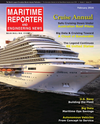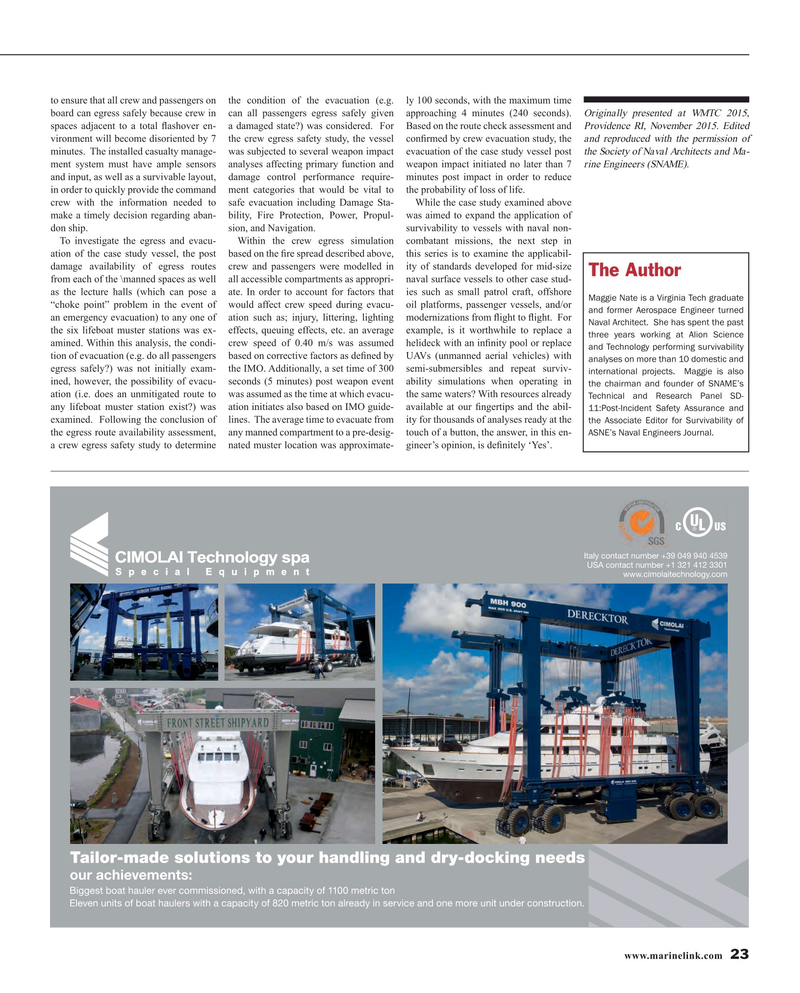
Page 23: of Maritime Reporter Magazine (February 2016)
Cruise Ship Technology Edition
Read this page in Pdf, Flash or Html5 edition of February 2016 Maritime Reporter Magazine
to ensure that all crew and passengers on the condition of the evacuation (e.g. ly 100 seconds, with the maximum time board can egress safely because crew in can all passengers egress safely given approaching 4 minutes (240 seconds). Originally presented at WMTC 2015, spaces adjacent to a total ? ashover en- a damaged state?) was considered. For Based on the route check assessment and Providence RI, November 2015. Edited vironment will become disoriented by 7 the crew egress safety study, the vessel con? rmed by crew evacuation study, the and reproduced with the permission of minutes. The installed casualty manage- was subjected to several weapon impact evacuation of the case study vessel post the Society of Naval Architects and Ma- ment system must have ample sensors analyses affecting primary function and weapon impact initiated no later than 7 rine Engineers (SNAME).
and input, as well as a survivable layout, damage control performance require- minutes post impact in order to reduce in order to quickly provide the command ment categories that would be vital to the probability of loss of life.
crew with the information needed to safe evacuation including Damage Sta- While the case study examined above make a timely decision regarding aban- bility, Fire Protection, Power, Propul- was aimed to expand the application of don ship. sion, and Navigation. survivability to vessels with naval non-
To investigate the egress and evacu- Within the crew egress simulation combatant missions, the next step in ation of the case study vessel, the post based on the ? re spread described above, this series is to examine the applicabil- damage availability of egress routes crew and passengers were modelled in ity of standards developed for mid-size
The Author from each of the \manned spaces as well all accessible compartments as appropri- naval surface vessels to other case stud- as the lecture halls (which can pose a ate. In order to account for factors that ies such as small patrol craft, offshore
Maggie Nate is a Virginia Tech graduate “choke point” problem in the event of would affect crew speed during evacu- oil platforms, passenger vessels, and/or and former Aerospace Engineer turned an emergency evacuation) to any one of ation such as; injury, littering, lighting modernizations from ? ight to ? ight. For
Naval Architect. She has spent the past the six lifeboat muster stations was ex- effects, queuing effects, etc. an average example, is it worthwhile to replace a three years working at Alion Science amined. Within this analysis, the condi- crew speed of 0.40 m/s was assumed helideck with an in? nity pool or replace and Technology performing survivability tion of evacuation (e.g. do all passengers based on corrective factors as de? ned by UAVs (unmanned aerial vehicles) with analyses on more than 10 domestic and egress safely?) was not initially exam- the IMO. Additionally, a set time of 300 semi-submersibles and repeat surviv- international projects. Maggie is also ined, however, the possibility of evacu- seconds (5 minutes) post weapon event ability simulations when operating in the chairman and founder of SNAME’s ation (i.e. does an unmitigated route to was assumed as the time at which evacu- the same waters? With resources already
Technical and Research Panel SD- any lifeboat muster station exist?) was ation initiates also based on IMO guide- available at our ? ngertips and the abil- 11:Post-Incident Safety Assurance and examined. Following the conclusion of lines. The average time to evacuate from ity for thousands of analyses ready at the the Associate Editor for Survivability of the egress route availability assessment, any manned compartment to a pre-desig- touch of a button, the answer, in this en-
ASNE’s Naval Engineers Journal.
a crew egress safety study to determine nated muster location was approximate- gineer’s opinion, is de? nitely ‘Yes’.
Italy contact number +39 049 940 4539
USA contact number +1 321 412 3301 www.cimolaitechnology.com
Tailor-made solutions to your handling and dry-docking needs our achievements:
Biggest boat hauler ever commissioned, with a capacity of 1100 metric ton
Eleven units of boat haulers with a capacity of 820 metric ton already in service and one more unit under construction.
www.marinelink.com 23
MR #2 (18-25).indd 23 2/3/2016 10:28:26 AM

 22
22

 24
24
